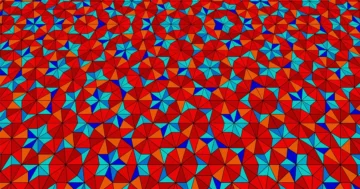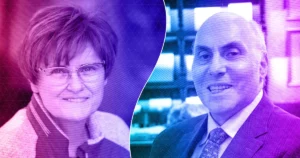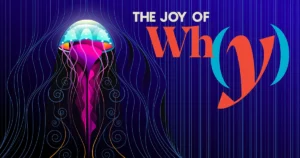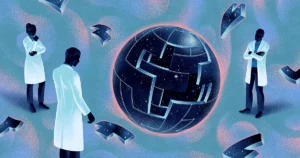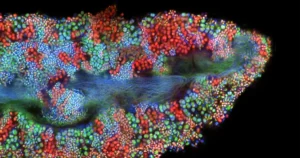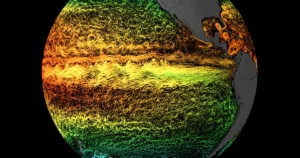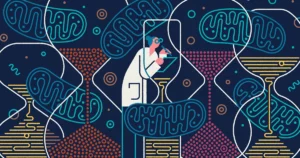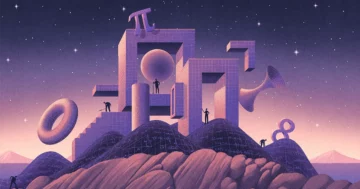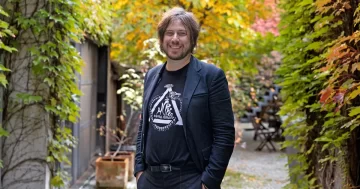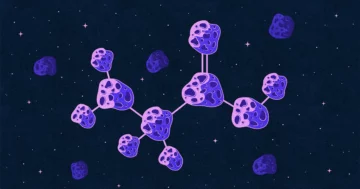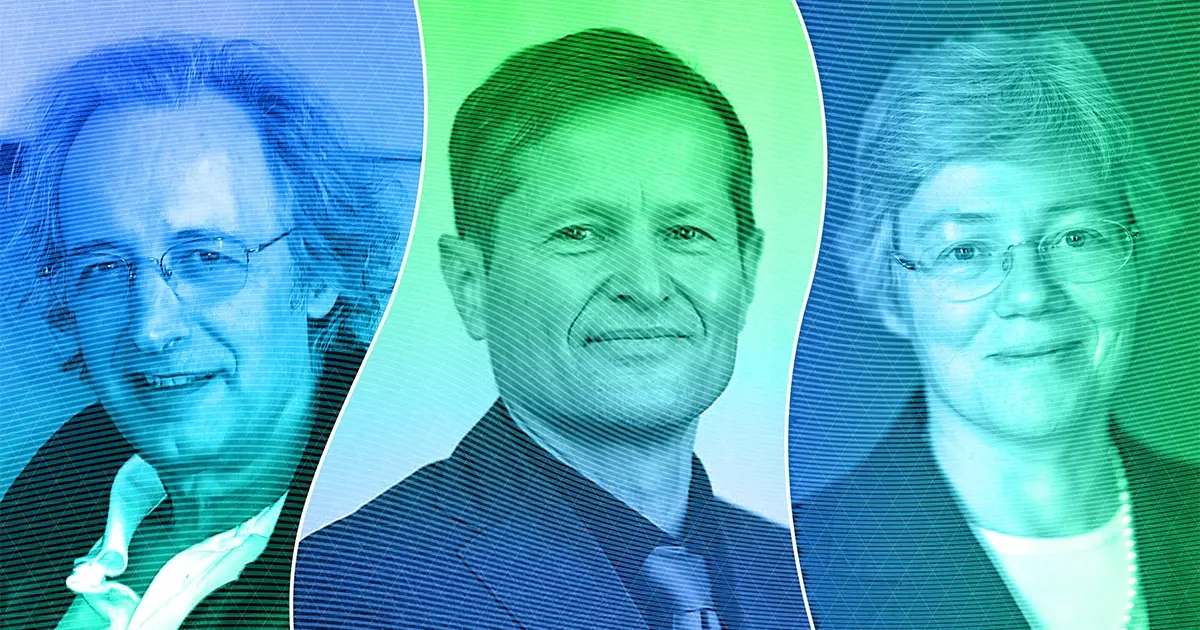
Introduction
To catch a glimpse of the subatomic world’s unimaginably fleet-footed particles, you need to produce unimaginably brief flashes of light. Anne L’Huillier, Pierre Agostini and Ferenc Krausz have shared the 2023 Nobel Prize in Physics for their pioneering work in developing the ability to illuminate reality on almost inconceivably brief timescales.
Between the 1980s and the early 2000s, the three physicists developed techniques for producing laser pulses lasting mere attoseconds — periods billions of billions of times briefer than a second. When viewed in such short flashes, the world slows down. The beat of a hummingbird’s wings becomes an eternity. Even the incessant buzzing of atoms becomes sluggish. On the attosecond timescale, physicists can directly detect the motion of electrons themselves as they flit around atoms, skipping from place to place.
“The ability to generate attosecond pulses of light has opened the door on a tiny — extremely tiny — timescale. It has also opened the door to the world of electrons,” said Eva Olsson, chair of the Nobel Committee for Physics and a physicist at the Chalmers University of Technology.
In addition to being a fundamentally new way of studying electrons, this method for viewing the world in ultraslow motion may lead to a host of applications. Mats Larsson, a member of the Nobel committee, credited the technique with launching the field of “attochemistry,” or the ability to manipulate individual electrons using light. Shoot attosecond laser pulses at a semiconductor, he continued, and the material almost instantaneously snaps from blocking the flow of electricity to conducting electricity, potentially allowing for the production of ultrafast electronic devices. And Krausz, one of this year’s laureates, is also attempting to harness the power of attosecond pulses to detect subtle changes in blood cells that could indicate the early stages of cancer.
The world of the ultrafast is entirely different from our own, but — due to the work of L’Huillier, Agostini, Krausz and other researchers — it is one that is just coming into view.
What is an attosecond?
One attosecond is one-quintillionth of a second, or 0.000000000000000001 seconds. More attoseconds pass in the span of one second than there are seconds that have passed since the birth of the universe.
To clock the movements of planets, we think in days, months and years. To measure a human running the 100-meter dash, we use seconds or hundredths of a second. But as we dive deep into the submicroscopic world, objects move faster. To measure near-instantaneous movements, such as the dance of electrons, we need stopwatches with far finer tick marks: attoseconds.
In 1925, Werner Heisenberg, one of the pioneers of quantum mechanics, argued that the time it takes an electron to circle a hydrogen atom is unobservable. In a sense, he was correct. Electrons don’t orbit an atomic nucleus the way planets orbit stars. Rather, physicists understand them as waves of probability that give their odds of being observed at a certain place and time, so we can’t measure an electron literally flying through space.
But in another sense, Heisenberg underestimated the ingenuity of 20th-century physicists like L’Huillier, Agostini and Krausz. The odds of the electron being here or there shift from moment to moment, from attosecond to attosecond. And with the ability to create attosecond laser pulses that can interact with electrons as they evolve, researchers can directly probe various electron behaviors.
How do physicists produce attosecond pulses?
In the 1980s, Ahmed Zewail at the California Institute of Technology developed the ability to make lasers strobe with pulses lasting a few femtoseconds — thousands of attoseconds. These blips, which earned Zewail the 1999 Nobel Prize in Chemistry, were enough to allow researchers to study how chemical reactions unfold between atoms in molecules. The advance was billed as “the world’s fastest camera.”
For a time, a faster camera seemed unattainable. It wasn’t clear how to make light oscillate any more quickly. But in 1987, Anne L’Huillier and her collaborators made an intriguing observation: If you shine a light on certain gases, their atoms will become excited and reemit additional colors of light that oscillate many times faster than the original laser — an effect known as “overtones.” L’Huillier’s group found that in gases like argon, some of these extra colors appeared brighter than others, but in an unexpected pattern. At first, physicists weren’t sure what to make of this phenomenon.
In the early 1990s, L’Huillier and other researchers used quantum mechanics to calculate the different intensities of the various overtones. They could then predict exactly how, when a slowly oscillating infrared laser hit a cloud of atoms, those atoms would in turn emit beams of quickly oscillating “extreme ultraviolet” light. Once they understood which overtones to expect, they worked out ways to overlay them so that they added up to a new wave: one with peaks surging on the attosecond scale. Coaxing giant collectives of atoms to produce these finely tuned waves in concert is a process Larsson likened to an orchestra producing music.
Over the following years, physicists harnessed this detailed understanding of overtones to create attosecond pulses in the lab. Agostini and his group developed a technique called Rabbit, or “reconstruction of attosecond beating by interference of two-photon transitions.” With Rabbit, in 2001 Agostini’s group generated a string of laser pulses, each lasting 250 attoseconds. The same year, Krausz’s group used a slightly different method known as streaking to produce and study individual bursts, each lasting 650 attoseconds. In 2003, L’Huillier and her colleagues bested them both with a laser pulse lasting just 170 attoseconds.
The femtosecond barrier had been shattered.
What can you do with attosecond pulses?
Attosecond pulses let physicists detect anything that changes over a span of dozens to hundreds of attoseconds. The first application was to try what physicists had long thought impossible (or at least extremely improbable): to see exactly what electrons are up to.
In 1905, Albert Einstein kick-started the field of quantum mechanics with his explanation of the photoelectric effect, in which shining light onto a metal plate launches electrons into the air (he would later win the 1921 Nobel Prize in Physics for his theory). Before the age of attosecond physics, physicists generally assumed that the chain of reactions that led to the liberation of those launched electrons was instantaneous.
In 2010, Krausz and colleagues showed otherwise. They used attosecond pulses to clock electrons that were knocked loose from neon atoms. In particular, they found that an electron in a lower-energy state flees its host 21 attoseconds faster than one in a higher-energy state. And in 2020, another group showed that electrons escape tens of attoseconds faster from liquid water than from water vapor.
Further applications of attosecond pulses are under development. The technique could probe a variety of electron goings-on, including how the particles carry and block electric charge, how electrons bounce off one another, and how electrons collectively behave. Krausz is also shining attosecond flashes on human blood. Last year he helped show that minuscule changes in a blood sample can indicate whether a person has an early-stage cancer, and what kind.
Earlier this morning, the Nobel committee had trouble reaching L’Huillier to inform her that she was the fifth woman in history to earn the physics Nobel. When they finally did, after three or four missed calls, she was in the middle of giving a lecture to her students. She managed to complete it, although she said the last half hour was very difficult. “I am very touched at the moment,” she later said.
- SEO Powered Content & PR Distribution. Get Amplified Today.
- PlatoData.Network Vertical Generative Ai. Empower Yourself. Access Here.
- PlatoAiStream. Web3 Intelligence. Knowledge Amplified. Access Here.
- PlatoESG. Carbon, CleanTech, Energy, Environment, Solar, Waste Management. Access Here.
- PlatoHealth. Biotech and Clinical Trials Intelligence. Access Here.
- Source: https://www.quantamagazine.org/physicists-who-explored-tiny-glimpses-of-time-win-nobel-prize-20231003/
- :has
- :is
- ][p
- $UP
- 1999
- 2001
- 2010
- 2020
- 22
- 250
- a
- ability
- added
- addition
- Additional
- advance
- After
- age
- ahmed
- AIR
- allow
- Allowing
- almost
- also
- Although
- am
- an
- and
- Another
- any
- anything
- appeared
- Application
- applications
- ARE
- argued
- around
- AS
- assumed
- At
- atom
- attempting
- barrier
- become
- becomes
- been
- before
- being
- between
- billions
- birth
- Block
- blocking
- blood
- both
- Bounce
- brighter
- but
- Buzzing
- by
- calculate
- california
- called
- Calls
- camera
- CAN
- Cancer
- carry
- Catch
- Cells
- certain
- chain
- Chair
- Changes
- charge
- chemical
- chemistry
- Circle
- clear
- Clock
- Cloud
- colleagues
- collectively
- coming
- committee
- concert
- conducting
- continued
- correct
- could
- create
- dance
- Dash
- Days
- deep
- detailed
- developed
- developing
- Development
- Devices
- DID
- different
- difficult
- directly
- dive
- do
- Dont
- Door
- down
- dozens
- due
- each
- Early
- early stage
- earn
- earned
- effect
- einstein
- Electric
- electricity
- Electronic
- electrons
- enough
- entirely
- escape
- Even
- evolve
- exactly
- excited
- expect
- explanation
- Explored
- extra
- extremely
- far
- faster
- fastest
- few
- field
- fifth
- Finally
- First
- flow
- flying
- following
- For
- found
- four
- from
- fundamentally
- generally
- generate
- generated
- giant
- Give
- Giving
- Glimpse
- Glimpses
- Group
- had
- Half
- harness
- Have
- he
- her
- here
- his
- history
- Hit
- host
- hour
- How
- How To
- HTML
- HTTPS
- human
- Hundreds
- hydrogen
- if
- illuminate
- impossible
- Improbable
- in
- Including
- indicate
- individual
- inform
- ingenuity
- instantaneously
- Institute
- interact
- interference
- into
- intriguing
- IT
- ITS
- just
- Kind
- known
- lab
- laser
- lasers
- Last
- Last Year
- lasting
- later
- launched
- launches
- launching
- lead
- least
- Lecture
- Led
- let
- liberation
- light
- like
- Liquid
- Long
- made
- magazine
- make
- managed
- many
- material
- May..
- measure
- mechanics
- member
- mere
- metal
- method
- Middle
- missed
- moment
- months
- more
- morning
- motion
- move
- movements
- Music
- Nature
- Need
- Neon
- New
- nobel prize
- objects
- observed
- Odds
- of
- off
- on
- once
- ONE
- opened
- or
- Orbit
- original
- Other
- Others
- otherwise
- our
- out
- over
- own
- particular
- pass
- passed
- Pattern
- periods
- person
- phenomenon
- Physics
- Pierre
- Pioneering
- pioneers
- Place
- Planets
- plato
- Plato Data Intelligence
- PlatoData
- potentially
- power
- predict
- prize
- probability
- probe
- process
- produce
- producing
- Production
- pulse
- Quantum
- Quantum Mechanics
- quickly
- Rabbit
- rather
- reaching
- reactions
- Reality
- researchers
- running
- Said
- same
- Scale
- Science
- Second
- seconds
- see
- seemed
- semiconductor
- sense
- shared
- she
- shift
- shine
- Shoot
- Short
- showed
- since
- slightly different
- Slowly
- slows
- sluggish
- So
- some
- Space
- span
- stages
- Stars
- State
- Students
- Study
- Studying
- such
- sure
- surging
- takes
- techniques
- Technology
- tens
- than
- that
- The
- the world
- their
- Them
- themselves
- then
- theory
- There.
- These
- they
- think
- this
- those
- thought
- thousands
- three
- Through
- tick
- time
- times
- to
- touched
- transitions
- trouble
- try
- TURN
- under
- understand
- understanding
- understood
- Unexpected
- Universe
- university
- use
- used
- using
- variety
- various
- very
- View
- viewed
- viewing
- was
- Water
- Wave
- waves
- Way..
- ways
- we
- webp
- were
- What
- when
- whether
- which
- WHO
- will
- win
- with
- woman
- Work
- worked
- world
- world’s
- would
- year
- years
- you
- zephyrnet

